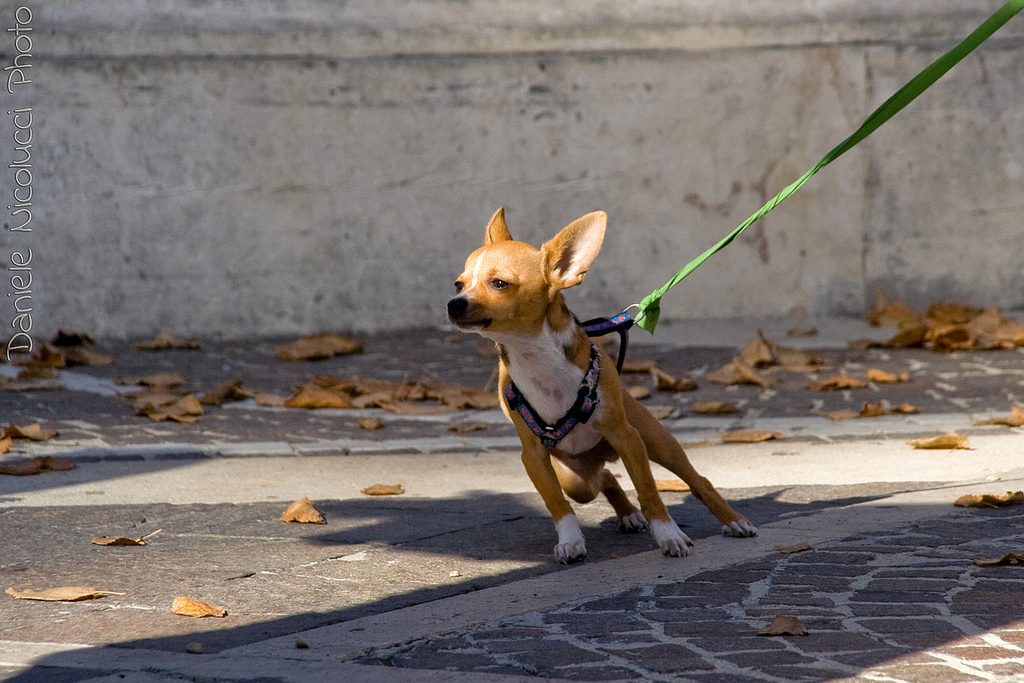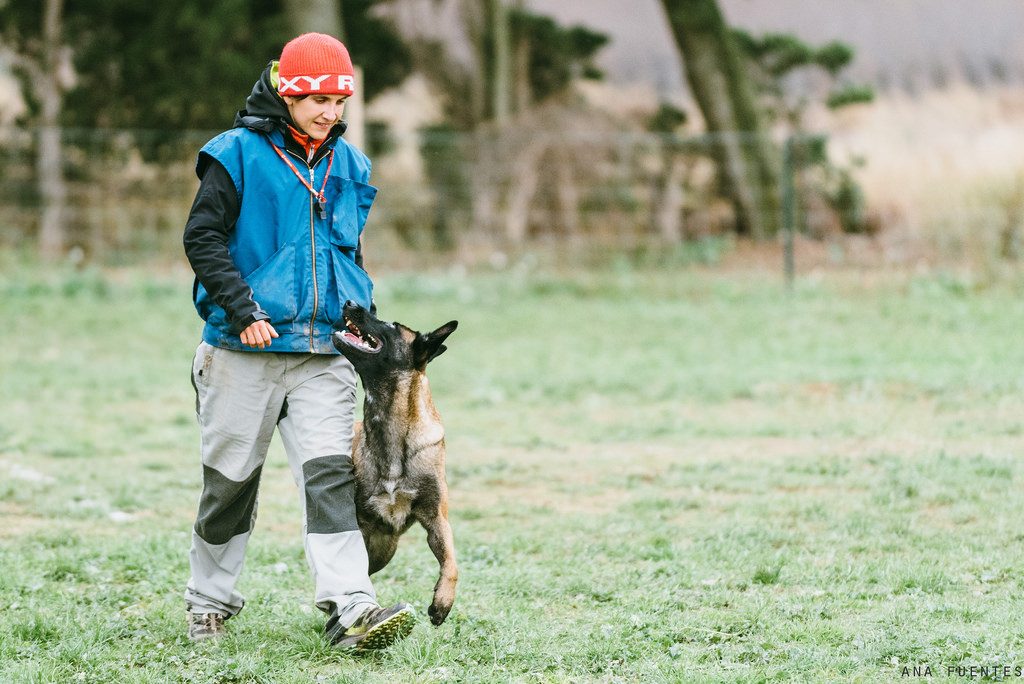- This post contains affiliate links. Read more here.
Ahh, Sunday morning, the perfect time for a long, leisurely stroll with your dog. You calmly clip the leash to her collar, open the front door, step outside…and suddenly, you feel like you’re at a tractor pull, and your dog is the tractor.
Pulling on the leash is one of the most common training challenges dog people face. A leash is important for safety and control, but walking nicely while tethered to a human doesn’t come naturally to most curious, excitable dogs on the move. Thankfully, with some patience, training, and treats, you can teach your dog loose-leash walking.
Read on for step-by-step tips on how to make dog walks fun.
Be Prepared
As with any training, you’ll want to start strong by gathering your supplies and loading up on rewards, a.k.a. delicious treats. Be sure to have that clicker in hand if you clicker-train your dog, or otherwise decide on the cue words, bridges (like a verbal “click”), and commands you will use.
Outfit your dog in a properly-fitted flat collar (there should be space for two fingers to fit snugly between your dog’s neck and the collar) or harness. You’ll also want to have a six-foot leash handy…but don’t clip it on just yet!
Start Off-Leash
It may seem counter-intuitive to teach your dog to go for walks on-leash by starting without one, but this is all about laying a solid foundation for the training to follow. Mastering the basics indoors can help. AKC trainer Erin Rakosky recommends starting in a securely-fenced outdoor area or open hallway indoors, and taking the following steps:
- First, walk around the space ignoring your dog.
- Then, call them to you in an enthusiastic tone, and reward them with a treat when they reach you.
- Continue to walk around the room, encouraging your dog to stay by your side. My favorite command for this is “let’s go!” Choose the cue that works for you—some people say “follow me,” or simply “walking!” The key is to use a bright, enthusiastic voice.
- As you walk, periodically reward your dog with a treat.
- Take periodic breaks during which you resume ignoring your dog, then call her to you again and continue walking. According to Rakosky, these breaks give the dog “a chance to take a mental break after working hard.” It gives you a break, too!
After a few sessions of off-leash walk training, your dog will know that good things come from sticking by your side.
Add the Leash, but Don’t Start Walking Yet
Once your dog is consistently walking by your side in the first step, it’s time to bring in the leash. Take your training back indoors to work on getting ready for a walk.
If your dog is already fairly calm, just clip the leash to her collar or harness, and reward her for staying still. If your dog is the type to start leaping in the air, spinning in circles, and generally having an ecstatic fit every time she hears a whisper of the word “walk” (I know mine is), you’ll need to train her to be calm before the leash goes on. The idea is to consistently reinforce the leash as a positive and unremarkable presence in your dog’s life, and prepare her to remain calm and by your side indoors and out.
Start by reaching for the leash. If your dog starts going crazy, quickly pull your hand back and just stand there. It’s tempting to talk to your dog, but actions speak louder than words, and if you calmly ignore her, she’s likely to take the hint and settle down more quickly. Reward your dog for sitting still and focusing on you. As soon as she’s calmly waiting, reach forward to clip on her leash. If she gets wound up again, simply pull your hands back and wait again.
Repeat the reach-and-wait sequence until your dog stands or sits calmly while you clip on her leash.
Hit the Streets

Via flickr/jolino
Okay, your dog comes when called, walks by your side off-leash, and stands still while you put on her collar and leash. It’s time to take it outdoors.
Don’t expect to be taking a long, leisurely stroll just yet. Instead, think about taking short, focused training walks of 5-15 minutes. You might not make if very far down the street, but remember, you’re putting in the work now to allow for productive walking later!
There are lots of methods for practicing loose-leash training:
- The “be a tree” method, or what dog trainer and behaviorist Victoria Stilwell calls “Stand and Be Still”: Whenever your dog pulls on the leash, immediately stop walking and stand still. Wait for your dog to either take a step back or turn to focus on you. When the leash is relaxed, continue walking. Repeat as necessary. (Note: you may find yourself stopping and starting constantly at first. That’s okay! Remember to be patient and give you and your dog breaks as needed)
- The “about turn” method: start walking with your dog. As she reaches the end of the leash, abruptly turn around and start walking in the other direction, using your “let’s go!” cue to keep your dog engaged in walking with you. The key to this method is to maintain a brisk pace and remember to reward your dog for getting it right. When she turns and walks at your side, click or say “yes” and give her a treat as you keep walking forward. At first, you may get dizzy with all those quick turns, but with consistency, your dog will learn to move forward at your side.
- The “penalty yards” method: if your dog continues to pull forward even when you stand still or turn around, you can add a penalty (not a punishment; remember, positive reinforcement is key) to show her that pulling makes good things go away. The Ontario SPCA training guide suggests that when your dog pulls forward, you should back up slowly with gentle pressure on the leash. Don’t be forceful or yank on the leash, simply back up. When your dog turns her focus back to you, reward her quickly and enthusiastically, and encourage her to keep walking by your side with a cheerful tone and body language.
These methods all help to teach your dog that pulling makes good things go away, and a loose leash makes rewards appear.
Use Walking Tools When Necessary
Training your dog to walk politely on a leash can take weeks or months of regular practice. In the meantime, your dog needs exercise, and you need to get from one place to another. One of the following humane walking tools can help:
- Head harnesses, such as Halti or Gentle Leader. These are designed to fit around your dog’s muzzle, with the leash attaching in front to gently turn her head when she goes to pull. Head harnesses can be very effective for short-term pull-prevention but must be properly fitted, introduced gradually, and used appropriately.
- Front-hook harnesses like the SENSE-ation or Easy Walk. Similar to head harnesses, a front-hook harness turns your dog back towards you when she pulls, discouraging pulling. The leash fastens on their chest.
- No-pull harnesses like Freedom or Holt. These harnesses discourage pulling by applying gentle pressure to the dog’s chest or legs when they strain at the leash.
These tools can all be quite useful but must be properly fitted, introduced gradually, and used appropriately. It’s important to never yank your dog’s leash while she’s wearing a head collar or no-pull harness, as they’re designed to gently and evenly distribute pressure to discourage pulling. Really, you should never yank your dog’s leash at all—that’s what this training is all about!
Keep It Up, and Remember to Have Fun
Training your dog is an important and necessary part of your life together, but let’s face it, all this repetition and back-and-forth can get tiring. The secret to successful training is to view it as a fun bonding activity, and even a game for you and your dog to play together. It’s also important to take it slow and remember to take breaks.
Most importantly, enjoy the world with your happy, curious, leash-friendly dog!



